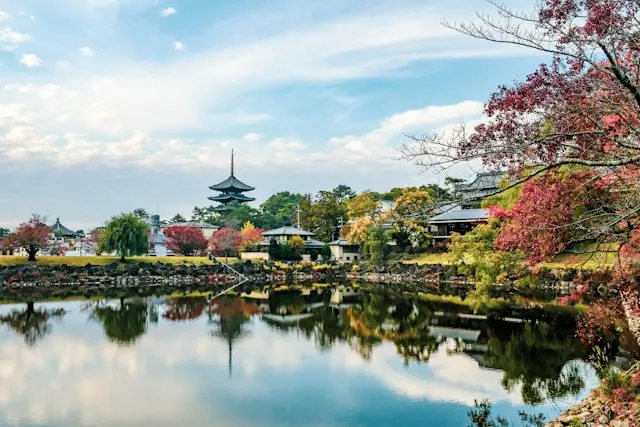
A Quick Look at the Elegant and Rustic “Naramachi”
Travel back to 710 AD, when Emperor Genmei relocated the capital to Heijō-kyō (modern-day Nara City and Yamato-Koriyama City), marking the beginning of the Nara Period. During this time, Asuka-dera Temple (then known as Hōkō-ji Temple), a key religious hub in the Asuka region, was relocated to Heijō-kyō’s outer district and renamed Gangō-ji Temple. Over time, the temple became the spiritual heart of the area, attracting residents, shops, and bustling commerce. Thus, the district of Naramachi began to take shape around Gangō-ji Temple. In 794 AD, when Emperor Kanmu moved the capital to Heian-kyō (modern Kyoto), the Nara Period came to an end, but Naramachi remained a thriving hub.
The Two Secrets of Naramachi: Uncovering the Fun!
1. Cute Red Monkeys Hanging at Every Door: Kōshin Belief
Walking through Naramachi, you’ll notice small, red-and-white, ball-shaped decorations hanging in front of almost every house. On closer inspection, you’ll realize they look like curled-up fabric dolls. What are they? These are “Kawari Saru” (Guardian Monkeys), charms believed to ward off misfortune and protect against evil. They originate from a folk belief known as Kōshin faith, which emphasizes spiritual protection.
• Kōshin Hall
Address: Nara Prefecture, Nara City, Nishishin’ya-chō
• Naramachi Information Center
Address: 14 Nishishin’ya-chō, Nara City, Nara Prefecture
Hours: 10:00 AM – 4:00 PM
2. Architectural Ingenuity for Saving Money: Unagi no Nedoko (“Eel Beds”)
Unlike grand buildings with wide facades, the old townhouses of Naramachi are understated and discreet, characterized by narrow wooden structures with long interiors. Why the compact facades? In the Edo period, taxes were based on the width of a building’s frontage along the street. To reduce their tax burden, residents made their entrances narrow while extending their homes lengthwise, creating what came to be known as “Eel Beds” (Unagi no Nedoko). Despite being designed for economy, these homes showcase thoughtful design: inner courtyards allow residents to enjoy seasonal views, and latticed windows balance privacy, sunlight, and ventilation—epitomizing the ingenuity and aesthetic of daily life in Nara.
• Naramachi Lattice House
Address: 44 Gangōji-chō, Nara City, Nara Prefecture
Hours: 9:00 AM – 5:00 PM
Closed: Mondays (or Tuesdays if Monday is a public holiday), December 26 – January 5
Discover the Charm of Naramachi
Now that you’ve uncovered these “secrets,” doesn’t Naramachi seem even more enchanting? With its unique shops, elegant architecture, lucky charms, and traces of local traditions, this district offers a delightful mix of shopping, sightseeing, and history. Be sure not to miss it on your next visit to Nara!
